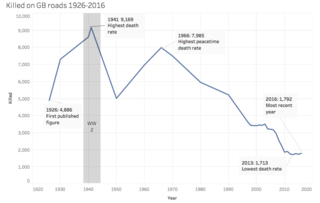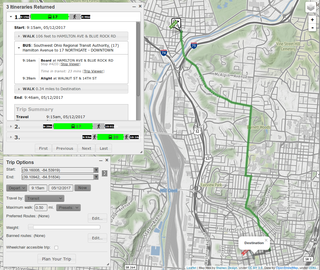Related Research Articles

Transportation engineering or transport engineering is the application of technology and scientific principles to the planning, functional design, operation and management of facilities for any mode of transportation in order to provide for the safe, efficient, rapid, comfortable, convenient, economical, and environmentally compatible movement of people and goods transport.

Weather forecasting is the application of science and technology to predict the conditions of the atmosphere for a given location and time. People have attempted to predict the weather informally for millennia and formally since the 19th century. Weather forecasts are made by collecting quantitative data about the current state of the atmosphere, land, and ocean and using meteorology to project how the atmosphere will change at a given place.

Transportation planning is the process of defining future policies, goals, investments, and spatial planning designs to prepare for future needs to move people and goods to destinations. As practiced today, it is a collaborative process that incorporates the input of many stakeholders including various government agencies, the public and private businesses. Transportation planners apply a multi-modal and/or comprehensive approach to analyzing the wide range of alternatives and impacts on the transportation system to influence beneficial outcomes.

Travel behavior is the study of what people do over geography, and how people use transport.

The Meteorological Office, abbreviated as the Met Office, is the United Kingdom's national weather service. It is an executive agency and trading fund of the Department for Business, Energy and Industrial Strategy and is led by CEO Penelope Endersby, who took on the role as Chief Executive in December 2018 and is the first woman to do so. The Met Office makes meteorological predictions across all timescales from weather forecasts to climate change.

The Department for Transport (DfT) is the United Kingdom government department responsible for the English transport network and a limited number of transport matters in Scotland, Wales and Northern Ireland that have not been devolved. The department is run by the Secretary of State for Transport, currently Grant Shapps.

The National Public Transport Access Node (NaPTAN) database is a UK nationwide system for uniquely identifying all the points of access to public transport in the UK. The dataset is closely associated with the National Public Transport Gazetteer.
The United Kingdom is the world's 10th biggest tourist destination, with over 39 million visiting in 2019, contributing a total of £234 billion to the GDP.

A green wave occurs when a series of traffic lights are coordinated to allow continuous traffic flow over several intersections in one main direction.

The GEH Statistic is a formula used in traffic engineering, traffic forecasting, and traffic modelling to compare two sets of traffic volumes. The GEH formula gets its name from Geoffrey E. Havers, who invented it in the 1970s while working as a transport planner in London, England. Although its mathematical form is similar to a chi-squared test, is not a true statistical test. Rather, it is an empirical formula that has proven useful for a variety of traffic analysis purposes.

Reported Road Casualties Great Britain (RRCGB), formerly Road Casualties Great Britain (RCGB) and before that Road Accidents Great Britain (RAGB), is the official statistical publication of the UK Department for Transport (DfT) on traffic casualties, fatalities and related road safety data. This publication, first produced in 1951, is the primary source for data on road casualties in Great Britain. It is based primarily on police STATS19 data. Data has been collected since 1926.

The Transport Direct Programme was a division of the UK Department for Transport (DfT) to develop standards, data and better information technology systems to support public transport. It developed and operates the Transport Direct Portal which is a public facing multi-modal journey planner. It also supports the creation and management of comprehensive databases of all public transport movements in the United Kingdom with Traveline. During 2010 two key datasets were released as Open Data and published on www.data.gov.uk.

Transportation forecasting is the attempt of estimating the number of vehicles or people that will use a specific transportation facility in the future. For instance, a forecast may estimate the number of vehicles on a planned road or bridge, the ridership on a railway line, the number of passengers visiting an airport, or the number of ships calling on a seaport. Traffic forecasting begins with the collection of data on current traffic. This traffic data is combined with other known data, such as population, employment, trip rates, travel costs, etc., to develop a traffic demand model for the current situation. Feeding it with predicted data for population, employment, etc. results in estimates of future traffic, typically estimated for each segment of the transportation infrastructure in question, e.g., for each roadway segment or railway station. The current technologies facilitate the access to dynamic data, big data, etc., providing the opportunity to develop new algorithms to improve greatly the predictability and accuracy of the current estimations.
The Urban Traffic Management Control or UTMC programme is the main initiative in the UK for the development of a more open approach to Intelligent Transport Systems or ITS in urban areas. Originating as a Government research programme, the initiative is now managed by a community forum, the UTMC Development Group, which represents both local transport authorities and the systems industry.

A journey planner, trip planner, or route planner is a specialized search engine used to find an optimal means of travelling between two or more given locations, sometimes using more than one transport mode. Searches may be optimized on different criteria, for example fastest, shortest, fewest changes, cheapest. They may be constrained, for example, to leave or arrive at a certain time, to avoid certain waypoints, etc. A single journey may use a sequence of several modes of transport, meaning the system may know about public transport services as well as transport networks for private transportation. Trip planning or journey planning is sometimes distinguished from route planning, which is typically thought of as using private modes of transportation such as cycling, driving, or walking, normally using a single mode at a time. Trip or journey planning, in contrast, would make use of at least one public transport mode which operates according to published schedules; given that public transport services only depart at specific times, an algorithm must therefore not only find a path to a destination, but seek to optimize it so as to minimize the waiting time incurred for each leg. In European Standards such as Transmodel, trip planning is used specifically to describe the planning of a route for a passenger, to avoid confusion with the completely separate process of planning the operational journeys to be made by public transport vehicles on which such trips are made.

The Transport Direct Portal was a distributed Internet-based multi-modal journey planner providing information for travel in England, Wales and Scotland. It was managed by Transport Direct, a division of the Department for Transport. It was launched in 2004 and was operated by a consortium led by Atos and later enhanced to include a cycle journey planning function. The closure of the portal was announced in September 2014 "Closure of the Transport Direct website"(PDF). Archived from the original(PDF) on 12 September 2014. and the portal closed on 30 September 2014.

International Futures (IFs) is a global integrated assessment model designed to help with thinking strategically and systematically about key global systems. It is housed at the Frederick S. Pardee Center for International Futures. Initially created by Barry B. Hughes of the Josef Korbel School of International Studies at the University of Denver in Colorado, the model is free for public use in both its online and downloadable forms.
Crown Copyright has been a long-standing copyright protection applied to official works, and at times artistic works, produced under royal or official supervision. In 2006, The Guardian newspaper's Technology section began a "Free Our Data" campaign, calling for data gathered by authorities at public expense to be made freely available for reuse by individuals. In 2010 with the creation of the Open Government Licence and the Data.gov.uk site it appeared that the campaign had been mostly successful, and since 2013 the UK has been consistently named one of the leaders in the open data space.

Peak car is a hypothesis that motor vehicle distance traveled per capita, predominantly by private car, has peaked and will now fall in a sustained manner. The theory was developed as an alternative to the prevailing market saturation model, which suggested that car use would saturate and then remain reasonably constant, or to GDP-based theories which predict that traffic will increase again as the economy improves, linking recent traffic reductions to the Great Recession of 2008.

Sir Philip McDougall Rutnam, is a British former civil servant who served as Permanent Under-Secretary of State at the Home Office from 2017 until his resignation on 29 February 2020. Prior to this, he was the Permanent Secretary at the Department for Transport for five years and also Acting Permanent Secretary at the Department for Business, Innovation and Skills in 2010.
References
- ↑ Sanderson Associates, https://www.transport-assessment.com/tempro.htm
- ↑ Metz, David (2012). "Demographic determinants of daily travel demand". Transport Policy. Elsevier BV. 21: 20–25. doi:10.1016/j.tranpol.2012.01.007. ISSN 0967-070X.
- ↑ Data.gov.uk NTEM https://data.gov.uk/dataset/11bc7aaf-ddf6-4133-a91d-84e6f20a663e/national-trip-end-model-ntem
- ↑ DfT https://www.gov.uk/government/publications/tempro-downloads